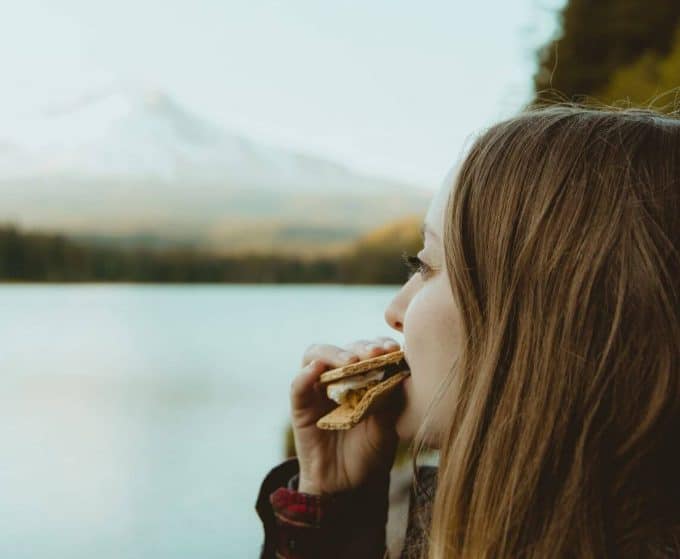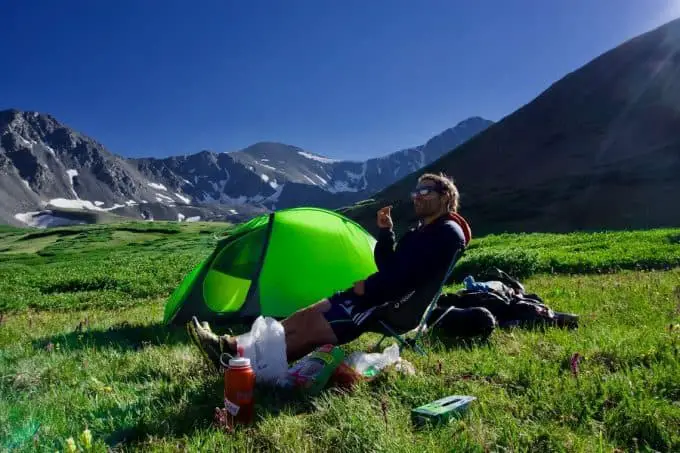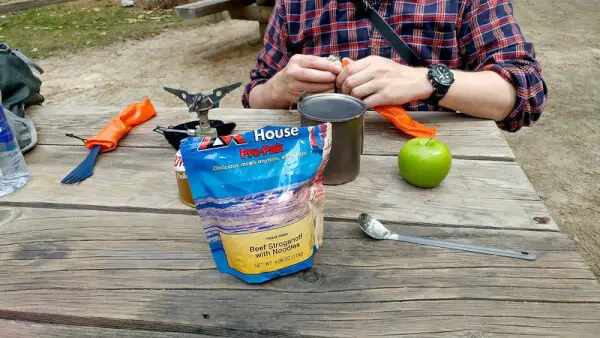Why do you go backpacking? You can ask this question as many times as you want and still hear new answers. Everybody has their own reasons for leaving behind their 9-5 and clocking some time on the trail. For starters there’s the view. Some folks relish the feeling that it’s “them against nature” or even against themselves, pushing their endurance to new heights as they rack up the miles.
Whatever your reason, I can guarantee you that nobody–really, nobody!–in the history of backpacking has ever said that they sling their pack in hopes of a boring trip. That’s part of the wonder of backpacking. Even if you go spend a week on the same trails every summer, each year holds the promise of something new. New experience, views, and challenges.
That promise of adventure, after all, is what keeps us coming back for more. We work out packing lists trying to anticipate our needs because we know that the unexpected is a natural part of this journey. Why, then, do we seem to pack the same old trail foods every time we head for the backcountry? I don’t know about you, but I don’t think I can stomach another zip-loc full of the same old trail mix. I mean it–even the kind that has M&Ms.
See also: Vegan Backpacking Food: Tasty Nutritious Food Choices for Outdoor Lovers
Luckily, there is a better way. Backpackers are just afraid to embrace it, or simply at a loss for how to turn around their drab eating plans. Your meals ought to be as varied as your backpacking experiences–not necessarily gourmet feasts, but at the very least something a little bit different and interesting each day.
It is possible, with careful planning and some ingenuity(which you probably have lots of if your second love is a hiking pack) to create a varied menu that will last through longer treks and still provide truly tasty nutrition to help you power through the long slogs. Stay tuned for some killer backpacking lunch ideas.
What Makes Good Trail Food?
Of course, before we can get down and dirty with a new shopping list, it’s important to revisit exactly what makes a worthwhile trail food. Focusing on these criteria can help you see foods (that you perhaps wouldn’t have considered packing in the past) in a new light.
Lightweight
Like anything else, your food is going to go in your pack. Luckily the means that it’ll be the biggest annoyance when you first start out and only get lighter as you eat your way through your supplies. Still, though, it’s important to try to pack foods that weigh less or come in packaging that doesn’t add unnecessary ounces.
This is actually why most canned goods don’t make it onto the list for hikers. Sure, they’re more shelf stable than other options. However, think about the logistics of loading up your pack with a bunch of 10-14 ounce cans of soups, veggies, and the like. It’s heavy, it’s bulky, AND you end up with lots of empty cans you’ve got to tote with you. How about some no-frill, no-cook camping meal recipes you can try?
Well, that I hope you’ll tote with you until you come across a safe opportunity to dispose of them. They may be a pain, but if you decide to bring them, that shouldn’t mean you ignore LNT rules.
When considering which foods you may want to pack, take a moment to think about whether or not they’ll pull their weight. You don’t want to sacrifice precious ounces for a food you don’t like. However, you also don’t want to bring something along simply because it’s your “favorite” if it’s going to overload your pack or make organizing difficult due to the packaging.
Nutrient-Dense
You’ll also need to consider how much nutritional value a food brings in comparison to its weight. For instance, if all you packed was red vines and crackers because they’re light, you would be in a sorry state by the end of your trip.
Even more than in everyday life, nutrient density is an important consideration when stuffing your pack. You are spending the day being quite active. You’re taxing your muscles, your heart and lungs, even your brain as you try to find the best routes through difficult terrain. All this work burns calories, and so of course you need to replace them, sometimes eating more calories than you would during a typical day.
Bringing us back to visions of candy and crackers, it isn’t just about the calories. You need calories that provide a proper balance of carbohydrates, protein and fats. It’s also a good idea to plan ways to replace the electrolytes you’re losing in your sweat in order to avoid muscle cramping and other unpleasant physical symptoms.
For each item you’re placing in your back, think about what it brings to the table from a nutritional standpoint. You can get all of these nutrients more easily if you vary the menu, and you’ll end up enjoying mealtimes more because it won’t feel like just another grim calorie dump to keep you on your feet for the next few hours.
Refueling in a way that helps your body but also tastes good can turn a lunch break into a refreshing respite from a hard day’s slog, improving the mood of your entire trip.
Trail Tough
The last important factor to consider is how well an item is going to hold up in your pack during your trip. It doesn’t matter how lightweight and healthful a food item is; if it’s going to be crushed into dust by the end of your first day on the trail then it simply doesn’t merit packing.
Sometimes this means you’ve got to leave favorite foods behind. Not always, though. You may be surprised to find that many of your favorite foods which ordinarily don’t make it into your pack have hardier versions that are tough enough for the trail.
Specific examples will be mentioned in the hiking lunch ideas below, but it does bear keeping in mind that you can tweak you pack towards the tastier side if you do a little extra shopping.
For certain favorites, though, exceptions can always be made. If you have something more delicate that you really want to bring along, you can always consider wrapping it in a bandana or other bit of fabric, and lashing it to the outside of your pack. This way it won’t get crushed beneath the weight of the other contents inside.
These factors may seem pretty superficial at first, but if you really put some mental elbow grease into figuring out what foods fit the bill you may end up discovering new options. Try this: the next time you walk into your kitchen to grab a snack, look at what’s in your fridge through the lens of packing for the trail. What works, what doesn’t work, and what options you’ve never explored before may surprise you.
Quick, Easy Backpacking Lunches
If you have lots of hiking buddies, you’ve heard dozens of theories about the perfect eating strategy on the trail. Some folks say you needs to eat lots of small meals–keeping your energy up without bogging you down. Others claim this is just plain rubbish, and every meal should be savored, filling your belly and reigniting your desire to continue the slog.
My theory is that everybody is right. All of these strategies work as long as you implement them well, and they all have different directives to be followed when packing your lunches.
The Grazer
The Grazer is the hiker who only ever seems to eat a full meal at dinnertime, after you’ve made camp. Grazers typically eat a light breakfast and seem to completely forgo lunch in favor of a string of snacks that carries them through the middle of the day. If you’re a grazer, there’s nothing wrong with packing like one.

In fact, one of the neat things about this style of eating is that you have less pressure to choose which foods to take with you because you get to have a little bit of everything. Small portions of lots of different easy foods makes for lots of variety. Grazers can sometimes cover more miles in a day, too.
When you’re hungry and grazing it’s easy to pull a snack out of the top of your pack. Most of the time you don’t even have to stop because you’re not having a full meal. You can eat on the go, and the steady stream of energy you’re giving your body helps you to continue traveling at an even pace all day. Think of a grazer as the tortoise rather than the hare.
Here are some foods you might pack for lunch if you want to try out grazing:
- Dried Fruit
- Nuts/Seeds (custom trail mix)
- Fig Bars
- Protein/Energy Bars
- Single-Serve Cheese (Laughing Cow or similar)
As you can see, none of these really constitute a full meal. The idea is to give you just enough fuel to keep going, and you would typically eat anywhere from two to four snack through the middle of the day if you were trying out grazing.
Meal bars are an easy solution; you can find a wide variety of flavors and many brands are geared towards athletes, providing the nutritional content needed to boost endurance.
Dried fruits, nuts and seeds can be eaten individually or you can create interesting trail mixes. One day you might have Macadamia nuts, dried pineapple, and flax seeds, while another day you might go with a more classic option like roasted peanuts and cacao nibs. See our article on easy to make trail mix to take along for your next camping trip.
As long as your snacks are shelf stable and won’t get ruined in your pack, there really is no wrong answer here. And hey, if you discover you don’t like something you packed, take comfort in knowing the next meal can be completely different!
The Overachiever
I’ll be the first to admit that I am 100% the overachiever when I hike. Us folks are sometimes a little bit too goal-oriented for our own good. We like to plan daring trips, with schedules that seems to toe the line when it comes to how many miles you can really expect your group to cover in a day.
The thing is, it’s totally possible to cover these longer distances if you practice time-saving strategies when and where you can. Sure, we can get a bit intense at times. No, it’s probably not necessary to try and use the loo at hyperspeeds instead of taking a full-fledged bathroom break.
But when you get farther into the backcountry than most people in the area have gone and you get to see those truly wild horizons, it’s all worth it.
Part of how overachievers make this happen is an attitude towards mealtimes that is a little bit spartan. Recognizing the need to take a bit of a breather around midday in order to avoid burning out too early in the afternoon, sit-down lunches are common.
Not a full-blown meal with conversation and a fire, mind you. Really just sitting down for a few minutes, stuffing some calories in your face, stretching out your calves, and then hitting the trail once more.
These are some quick meal ideas for overachievers:
- Nutella and peanut butter wrap
- Salami and shelf-stable cheese on seed crackers
- Pouch-packed tuna w/single-serve mayo packets
- Pouch-packed chicken w/ taco sauce and a bagel
- Pita bread and instant hummus
- Powdered drink mixes
In addition to providing a welcome change from water, powdered drink mixes are a tasty way to help recoup lost electrolytes. Don’t buy kool-aid or another mostly-sugar variety. Try out options like Propel that give you what you need without funky dyes or added chemicals. If you have a few minutes to sit down and eat, dropping one of these into some water can be a nice treat that’ll keep you going.
The actual meal options listed are a little bit hardier than what the grazer would choose, but everything can be made, eaten, and cleaned up after relatively quickly. These are the lunches for folks who want to refuel in 10-15 minutes without making a big fuss over lunchtime.
The Conversationalist
If you find yourself baffled at the get-up-and-go-go-go attitude of grazers and overachievers, then you’re probably a conversationalist. Conversationalists don’t put a huge premium on making it to any specially remote destinations–they like backpacking as a way to relax and recharge.
There’s nothing at all wrong with this, it is just a very different style than the first two groups, and that style is reflected in the attitude towards meals as well. If you’re just fine with deviating from distance goals and not hiking as far as originally planned in a given day, then it can be wonderfully relaxing to turn lunch into an hour-long affair that involves chatting and power naps.
For most people, it’d still seem like too much work to set up a fire and cook a hot meal, but there are certainly plenty of hearty options to give you a more substantial midday meal:
- Greenbelly meals
- Tea
- Instant soup mixes
- Homemade dehydrated meal packs
- Mountain House meals
I know, I know; those that few require hot water. Here’s a secret: they don’t. You can pour cool water in and wait 30 minutes instead of 10, and you’ll still get your food.
If you really love the idea of a hot meal though, boil some water at breakfast time before you break camp and store it in a well-insulated thermos. Come lunch it should still be hot enough to give you the warm comfort food you’re looking for.
Tea is another way to turn lunch into a cozier, relaxing meal. Taking the extra time for these small comforts is a nice way to rejuvenate if you’re having a particularly hard day on the trail.
Or, if you’re just looking for a full tummy, consider Greenbelly meals. Somewhere between an MRE and a protein bar, these are made with all natural ingredients, but with higher calorie counts than most meal replacement bars so you won’t be starving in an hour. One package (meal) comes with two bars that are larger and take longer to eat than a typical meal bar, but they’ll certainly keep you full till dinner.
Ready To Hit The Trail?
I hope this article has been helpful. There are so many different ways to pack great lunches while backpacking, and my aim was to open your eyes to new possibilities in terms of not only what you eat, but how you integrate mealtimes into your day while on the trail.

Here’s a quick overview of the three basic meal types covered in this guide:
- The Grazer: great for indecisive folks who want to pack everything in their pantry, or anyone who likes lots of snacks
- The Overachiever: quick and easy, no-nonsense meals that provide renewed energy without taking too much time
- The Conversationalist: a good change of pace when you have a terrible day on the trail, or if you just plain don’t like rushing.
So, which one are you? Leave a comment and let’s see who dominates the trails!
For more DIY backpacking food ideas, do check out the link for reference.
Featured Image Source: https://www.flickr.com/photos/99658898@N00/33264481340





